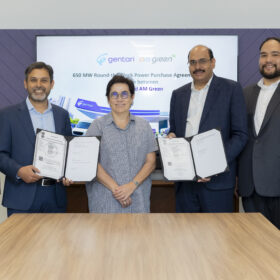The Hydrogen Stream: IGI Poseidon, Corinth Pipeworks test H2 transport pipes
IGI Poseidon has partnered with Corinth Pipeworks to test carbon-steel pipes for hydrogen transport under high pressure, while Axpo has begun building a green hydrogen plant in Switzerland to fuel vessels and other applications from 2026.
Ohmium, Spirare Energy announce green hydrogen production at NTPC microgrid
The green microgrid project powers NTPC’s Energy Technology Research Alliance (NETRA) campus using a solar PV power generation system coupled with a hydrogen power storage system.
Coal-based steelmaking plans jeopardize India’s net-zero target
The “build now, decarbonize later” approach misses the opportunity to develop steel capacity using low-emissions technologies, which could make India a leader in green steel capacity, save on decarbonization efforts later, and reduce current and future stranded asset risk in the industry.
The Hydrogen Stream: Gentari to supply 650 MW round-the-clock renewable power to AMG Ammonia
Gentari will set up around 2.4 GWp of solar and wind power generation capacity in India, backed with 350 MW/2100 MWh energy storage, to supply firm and dispatchable green power to AMG Ammonia’s facilities
Bolstering energy transition through green hydrogen
By offering incentives for green hydrogen production and manufacturing electrolyzers, the government of India is making it easier for players to enter this space and scale up technologies. The focus on public-private partnerships is crucial to this effort, ensuring that both the public sector and private companies collaborate efficiently to make green hydrogen a reality impacting masses.
Panasonic powers UK factory with solar-driven hydrogen fuel cell generators
Panasonic has launched a solar-powered hydrogen fuel cell project at its factory in Cardiff, Wales, with the microwave assembly now operating on renewable energy.
TKIL Industries enters green hydrogen in alliance with Switzerland’s SoHHytec
TKIL Industries will be SoHHytec’s exclusive partner in India to manufacture and supply specific equipment as well as implement and install direct solar-to-green hydrogen projects.
The Hydrogen Stream: Greenzo Energy, EODev partner to launch Toyota hydrogen fuel cell-powered generators in India
Greenzo Energy will introduce EODev’s emission-free generators powered by Toyota hydrogen fuel cell technology in India and Nepal. This long-term partnership also includes provisions for local assembly of EODev products by Greenzo Energy.
The Hydrogen Stream: IIT Bombay, HSBC green hydrogen programme selects six innovative projects for incubation
The shortlisted technologies and solutions include energy-efficient green hydrogen generators, indigenous hydrogen storage systems for commercial vehicles, and alternative combustion burners to improve air quality.
Germany commits €24 billion to build national hydrogen network
KfW Development Bank has offered €24 billion ($25.2 billion) grant to bridge the gap between network operators’ high investment costs and the initially low revenues from network charges.













